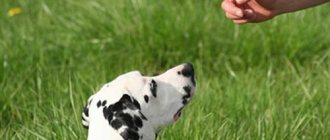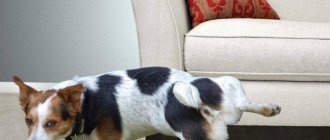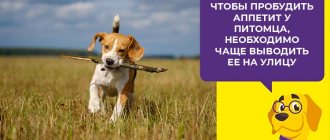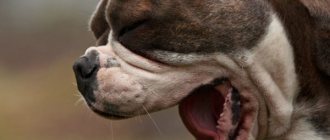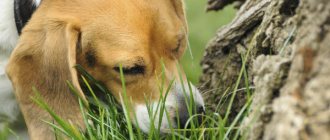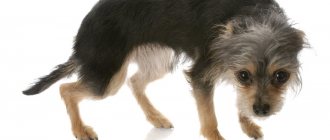(1 ratings, average: 5,00 out of 5)
Total 979 Today: 7
Your dearly beloved four-legged suddenly began to growl when you touched him and try to bite. Find out why the dog became aggressive and what the owner should do.
Aggression can have many causes. Abuse of the pet, lack of proper socialization, accumulation of daily stress or anxiety experienced by the pet. Problems like these don't arise overnight. The owners themselves are to blame for aggressive behavior. In such cases, the dog’s aggression is not sudden, but systematic, manifesting itself constantly.
What to do if an animal suddenly shows aggression? A calm and quiet dog suddenly begins to growl during play or when the owner tries to pet him.
Why might a dog growl at its owner?
A dog's growl is a sign of dissatisfaction. There may be several reasons for concern that provoke a dog’s aggression towards its owner:
- Personality formation. This usually happens in adolescence, when the male tries to assert himself and take a leading position. Suddenly, a demon breaks out of a meek, friendly dog, and he turns into an evil creature. Instincts are to blame for everything - the animal strives to become a leader. Tries to take over new territory, for example, the owner’s bed. It can growl and bark at guests, defending its possessions. By demonstrating fearlessness, the male confirms his importance.
- A response to cruelty. Aggression and violence on the part of the dog owner towards the pet provokes counter-anger. Shouting or beating cannot achieve obedience. This dog growls when you pet it. She is not used to affection, so she is always anxious in anticipation of impending danger. This means that trust in the owner has been lost, and the animal is in a state of constant stress.
- Defensive reaction. You may not realize how threatening your raised voice sounds. Excessively active gestures and behavior of the owner that is unusual for the dog may seem suspicious. For example, returning home in a state of alcoholic intoxication, an unfamiliar smell emanates from you, you behave strangely, your voice sounds different. The dog may have doubts: has his owner been replaced?
- Unconditional leader. The tendency to dominate is inherent in many breeds. It manifests itself in communication with surrounding people and other pets. By pampering and indulging his pet in every possible way, the owner makes a fatal mistake. The dog begins to jealously protect its belongings even from its owner. Seeks to take possession of objects that do not belong to her. With an animal grin she asserts her rights.
- Competitive fight. If there are other pets in the house, the dog will strive to take dominance. Skirmishes between animals are inevitable in the struggle for territory and the attention of the owner. If the owner takes the side of one of them, the second will harbor a grudge and become embittered.
- Aggression while eating. A common occurrence among ill-mannered pets. Distracted from food, the dog growls when the owner is nearby. If you try to take a bowl or bone from her, she may bite. Such pets are not trained to correctly take “sweets” from their hands and grab their fingers with their teeth.
- Losing control of the game. It would seem that a harmless growl or bark during play should not cause the puppy to become angry. But if the baby understands that this is normal, then over time he will begin to bite the owner. When an adult dog behaves this way, it becomes very sad.
- Hunting skills. There are similarities with game dogs, but they are based on the instinct of hunting dogs to track and drive prey. In urban conditions, a cat or other animal may become a victim. It is not normal if the owner tries to stop the pet and receives a grin in response. For centuries, hunting breeds have been ingrained in their kindness towards people.
- Excessive attention. Any living creature requires rest and tranquility. A dog may growl at a person if it is tired and irritated. So, if a child is chasing her all the time, she begins to snap at the level of instincts. Constant stress provokes the animal to growl.
- Unconscious aggression. The reaction often occurs in pets of guard breeds. If the dog is in deep sleep, he is not aware of what is happening. A sudden awakening from the noise forces him to defend himself. At the same time, he still does not understand who is standing in front of him and can even rush at the owner.
- Maternal instinct. A female puppy selflessly protects her offspring, sometimes even from the owner himself. This is a completely natural reaction, but it is strictly not recommended to encourage such behavior.
- Pain and malaise. The reasons for a dog's suffering when sick are not always visible. Experiencing pain and discomfort, the animal tries to hide in a secluded place to rest. If she is disturbed in this, she may bare her teeth and growl.
Reasons for aggression towards the owner
Any experienced dog breeder or dog handler will say with confidence that the unsatisfactory and dangerous behavior of an animal is the responsibility and omission of the owner. First of all, this applies to fighting and guard breeds, whose original purpose was definitely not to give love to everyone around them.
In such dogs, aggression runs in the blood, and in order to keep the same Alabai as a big and cute pet, it must be systematically suppressed using training methods based on rigor and discipline. Unfortunately, some owners do not calculate their own capabilities and, as a result, suffer from hierarchical aggression.
Constant indulgences
Sometimes love for an animal reaches such an extent that without realizing it, the dog’s owners themselves allow the dog to behave as a full-fledged leader. If your pet sleeps wherever he wants, eats first and receives praise even for dirty tricks, then you shouldn’t be surprised why a previously obedient dog began to ignore commands.
This attitude towards education (or rather the lack thereof) on the part of the animal’s owners creates a favorable environment for the dog to feel at the top of the hierarchical ladder and do as it pleases.
Lack of socialization
To form adequate reactions to the environment, the animal must be introduced to it. When faced with various people, objects and phenomena, the pet learns to interact with them. There is such a thing as the cottage dog syndrome, which is quite happy and obedient within its own territory, but is completely lost when it goes beyond it.
Thus, any kind of isolation of a pet negatively affects the degree of its socialization. And while communication with the owner may be acceptable, then a collision with an unknown creature, a stranger or a child will cause stress, anxiety, and a desire to defend or dominate.
Encouraging aggression towards other animals
Some dog breeders practice a rather strange activity: they set their pets against yard fauna. It is believed that in this way representatives of fighting breeds splash out accumulated energy. However, in fact, things look different.
The systematic manifestation of aggression, accompanied by encouragement, forms a conditioned reflex in the animal, which will be triggered when it sees other dogs or cats.
In addition, such behavior will be regarded as normal. In such cases, a situation often develops when homeless animals first suffer, and then the dog attacks the owner.
Physical punishment
This is a separate topic that involves re-education, rather, of the dog owner. A pet that systematically receives beatings from a person turns into a frightened creature. In the face of the owner, such a creature sees only a threat, as well as a source of pain, and he has no choice but to try to defend himself - to growl and rush.
We recommend this article:
How to successfully train an adult dog or puppy
Video “Aggression towards owners”
In this video, an expert will talk about the reasons for a dog’s aggression towards its owner.
For what reasons does a dog become dominant?
Some dog breeders claim that their pets suddenly changed their behavior out of the blue. But you need to understand that a dog cannot growl at its owner without a reason. Most likely, this is a consequence of gaps in upbringing.
Excessive love, lack of training regimen and all kinds of indulgence in the pet leads to dominant behavior of the animal. Every dog looks closely at its owner for the first time. He evaluates your reaction to his behavior, tries to grasp the line of permissiveness and understand how much you can be controlled.
If you miss this “evaluation” period, hoping that the dog will grow up and learn everything on its own, the pet will soon become the leader of the pack (family). At the slightest disapproval of his actions, punishment will follow - a growl or an attack on the owner.
A clear illustration of dominance:
- The animal dares to sleep in your bed. When the owner tries to take his place, he bares his teeth and growls angrily. After all, a leader has the right to choose the best place for himself.
- The dog can show both insatiable curiosity and open aggression towards guests coming into the house. At the same time, the owner is unable to pacify him or take him to another room.
- A well-mannered dog should wait for family members to dine, and only then count on its own portion. The “leader” rushes first to the table and demands tidbits. He takes the food into the room and snaps when you try to stop him.
- Ignoring commands by an adult dog that previously followed them. This is not a small puppy who could get carried away by playing and not hear the order. Insubordination is a clear demonstration of a dominant position. By its behavior, your pet indicates your poor leadership qualities. Irritation and empty screaming will only strengthen righteousness in the animal’s mind.
- During a walk, the dominant dog will run ahead of the owner and pull hard on the leash. Walking alongside means recognizing you as a leader.
- During the game, the animal sets the rules. If you try to do it your way, the pet will burst into barking or growling in displeasure.
Dogs are often respectful of adults, but children are treated as equals or at a lower level. They behave unrestrainedly with children, are irritable, bare their teeth and bite. This is especially true when parents yell at them in the presence of an animal.
Facts and statistics
Dogs have lived next to people for centuries. Quadrupeds and bipeds have adapted to live side by side, not in conflict, but in cooperation . Over the hundreds of years during which cynology has existed as a science, dogs have been under constant observation and study. The experience of owners, trainers and statistics allowed us to draw definite conclusions about the behavior of our players:
- More than 80% of dogs that growled or showed aggression towards people bit an owner or family member at least once. This fact does not imply only conscious actions, that is, statistics are compiled on facts - bites.
- Among people injured by pet dogs, more than 60% of victims are owners or family members of the owner.
- Of these 60% of family members bitten, more than 70% are young children and elderly people.
- When children are attacked, due to their small stature, more than 40% of bites and abrasions occur on the soft tissues of the face.
- If we look at bite statistics, more than 60% of bites are caused by domestic or “former” domestic dogs, that is, animals that were raised by humans.
Interesting, isn't it? This “scary” statistic scares many, but a dog doesn’t suddenly start biting! There are always, absolutely always, clear prerequisites for dog aggression, which includes growling towards people. The reasons for aggression are very diverse and can range from panic fear to the belief that dogs rule the world. The development of anger occurs very gradually and, fortunately, at each stage the dog’s behavior and motivation can be corrected.
No one has the right to judge an owner who misses the warning signs, since no reasonable person wants to be bitten. Inexperienced owners pay a lot of attention to maintaining order in the house. Experienced dog breeders are engaged in nurturing the pet’s personality. Missing important signals (if the owner has not encountered them before) is possible in both options.
Important! A dog that growls at its owner will bite sooner or later, the question is who and when.
Growling at the owner can be explained by three global reasons:
- Poor quality, ill-conceived breeding .
- Violation of the norms for keeping a dog, especially at an early age - unconscious encouragement of aggression, lack of socialization, obsessive attention from children or guests.
- Poor upbringing – frequent punishment, violence.
Aggression in any of its manifestations, like affection, is an emotion. Of course, feelings also have reasons, because the brain gives only those signals that are truly relevant. However, understanding how the nervous system works does not make it any easier to understand emotions and feelings. When correcting a dog's behavior, you can rely only on intuition. There are also statistically proven schemes, but each of them is adjusted depending on the dog’s temperament.
Note! Pure types of aggression practically do not occur, that is, the dog has a reason to growl and a trigger to bite.
What to do if a dog growls at its owner?
It does not matter what provokes the animal to behave aggressively. Something needs to be done if a dog bites and growls at its owner. Urgently take care of raising an arrogant dog, unless his reaction is associated with some kind of disease. In this case, you need to contact a veterinarian.
An ultrasonic whistle will help calm a dominant pet. It makes a disgusting sound for dogs, but the human ear can barely hear it. At the moment of aggression, whistle at it, and the dog will lose the desire to growl. Over time, a reflex will be formed to prohibit such behavior, and she will realize who is the real boss in the house.
Analyze your behavior to understand what gave the impetus to your pet to consider itself a leader:
- they gave in to his roar and gave in to him;
- agreed with the refusal to carry out the order;
- they praised the animal out of the blue and gave him “goodies” just like that.
The whole family needs to be involved in the re-education process. If at least someone tries to take pity or pamper you with a treat, then this person will find himself one step lower in the hierarchical ladder.
Expert opinion
Kuzmenko Olga Olegovna
Information about the expert
Ask a Question
In the case of large fighting breeds, it is better to contact a professional dog handler. You should not risk the health and life of your family and friends.
How to prevent such a problem?
Raising a puppy should be done from the first days of its appearance in the house. It is easier to prevent the onset of aggression in a baby than to try to retrain an adult pet.
How to stop a dog from growling at its owner at a young age:
- Set up a special place for sleeping and relaxing. It should be a comfortable bed so that the dog can be comfortable in it. During the day, the dog is allowed to change its location: lie down by the radiator or near the owner’s feet. You should not allow anyone to creep into your bed. Such encroachments must be stopped immediately.
- Determine the animal's diet. Stick to it strictly and don’t feed yourself before you do.
- Teach your baby to hygiene procedures. If you regularly brush your teeth, ears, wipe your eyes, comb, bathe or wash your paws, your puppy will take them for granted. Don't shout or gesture if he growls or tries to bite. Lightly press the animal's nose with your thumb and forefinger and sternly express your disapproval. After this, return to the procedure.
- Spend more time walking, play actively, increase its intensity. The puppy must spend a lot of energy so that he does not have the desire to misbehave in the house.
- If your dog growls or barks during play, you need to stop it. Come close to your pet and strictly say: “No!” But this game should not be continued.
To establish the hierarchy in the correct order, it is necessary to influence the main control points. These include the feeding system, as well as rewards, affection and punishment.
Feeding rules
- It is important to teach the dog patience: family members sit down at the table first.
- It is strictly forbidden to feed from the common table.
- The pet must start and finish the meal on command. A properly raised animal should obediently part with dishes and leftover food.
- Feed your dog holding the bowl in your hand if he is not ready to part with food voluntarily.
Never show your pet that you are afraid of him. As soon as you retreat, you will immediately lose the title of leader.
Useful video on the topic: why does a dog growl at its owner, and how to stop it from doing so?
Caresses, rewards and punishment
Even the most beloved dog cannot be praised and caressed all the time. He will accept this behavior more as a recognition of his dominance than as a simple manifestation of love. Use affection as a reward for obedience.
Dogs understand well when they are being fairly punished and when they are being offended for no reason. If he deserves praise or is guilty, he must receive a reward or punishment.
For education, it is better to imitate the reception of leaders. In a pack, the culprit is pressed to the ground by the withers and held there for some time. If the animal resists, it is sharply lifted off the ground so that it feels the helplessness of the situation. A limp body indicates recognition of the opponent as the leader.
Behavioral difficulties are always more difficult to correct than to prevent. When choosing a four-legged friend, be guided not only by external signs. Soberly assess your training abilities and your ability to dominate your chosen dog.
